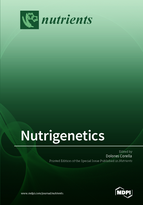Nutrigenetics
A special issue of Nutrients (ISSN 2072-6643).
Deadline for manuscript submissions: closed (30 April 2017) | Viewed by 117132
Special Issue Editor
2. CIBER Fisiopatología de la Obesidad y Nutrición, Instituto de Salud Carlos III, 28029 Madrid, Spain
Interests: precision nutrition; omics; Mediterranean diet; lifestyle; cardiovascular disease; obesity; nutrigenomics; epigenomics; metabolomics; transcriptomic; gene–diet interaction
Special Issues, Collections and Topics in MDPI journals
Special Issue Information
Dear Colleagues,
Precision Medicine, understood as “the emerging approach for disease treatment and prevention that takes into account individual variability in genes, environment, and lifestyle for each person” is currently one of the most talked about themes in biomedicine and great efforts are being made internationally to turn this concept into a reality. As the concept of Precision Medicine spreads, so too does that of “Precision Nutrition”, which would have to take individual variability into account when recommending personalized diets.
Although huge progress has been made over recent years in research into the genotype in inter-individual responses to diet, proving that this heterogeneity does indeed exist, we still do not have top level scientific evidence to make the eagerly-awaited personalized dietary recommendations, either from the prevention or treatment of different diseases point of view.
It is, therefore, essential to gather more information from studies which, from the nutrigenetic point of view, analyze gene-diet interactions in the different intermediate and final phenotypes of diseases. The ideal situation would be to have results available from randomized and controlled clinical trials. Results on gene-diet interactions obtained from large cohorts, and other types of studies with replication in independent samples, are also of great importance. Similarly, if nutrigenetic findings are accompanied by more mechanistic evidence, integrating other omics, this would be of particular interest. Lastly, another topic of interest is to share strategies for implementing genome-based nutritional interventions.
Therefore, this Special Issue of Nutrients, “Nutrigenetics”, will focus on providing evidence of the inter-individual genetic effects of diet in determining diseases phenotypes. We are looking forward to receiving many submissions from outstanding experts on these topics. Experimental papers, meta-analyses, up-to-date review articles, and commentaries are all welcome.
Prof. D. Corella Piquer
Guest Editor
Manuscript Submission Information
Manuscripts should be submitted online at www.mdpi.com by registering and logging in to this website. Once you are registered, click here to go to the submission form. Manuscripts can be submitted until the deadline. All submissions that pass pre-check are peer-reviewed. Accepted papers will be published continuously in the journal (as soon as accepted) and will be listed together on the special issue website. Research articles, review articles as well as short communications are invited. For planned papers, a title and short abstract (about 100 words) can be sent to the Editorial Office for announcement on this website.
Submitted manuscripts should not have been published previously, nor be under consideration for publication elsewhere (except conference proceedings papers). All manuscripts are thoroughly refereed through a single-blind peer-review process. A guide for authors and other relevant information for submission of manuscripts is available on the Instructions for Authors page. Nutrients is an international peer-reviewed open access semimonthly journal published by MDPI.
Please visit the Instructions for Authors page before submitting a manuscript. The Article Processing Charge (APC) for publication in this open access journal is 2900 CHF (Swiss Francs). Submitted papers should be well formatted and use good English. Authors may use MDPI's English editing service prior to publication or during author revisions.
Keywords
- Nutrigenetics
- Nutritional Genomics
- Gene-diet interactions
- Nutrigenomics
- Molecular Nutrition
- Precision Nutrition
- Inter-individual response
- Polymorphisms
- Genetic risk scores
- Dietary patterns
- Diet
- Omics







